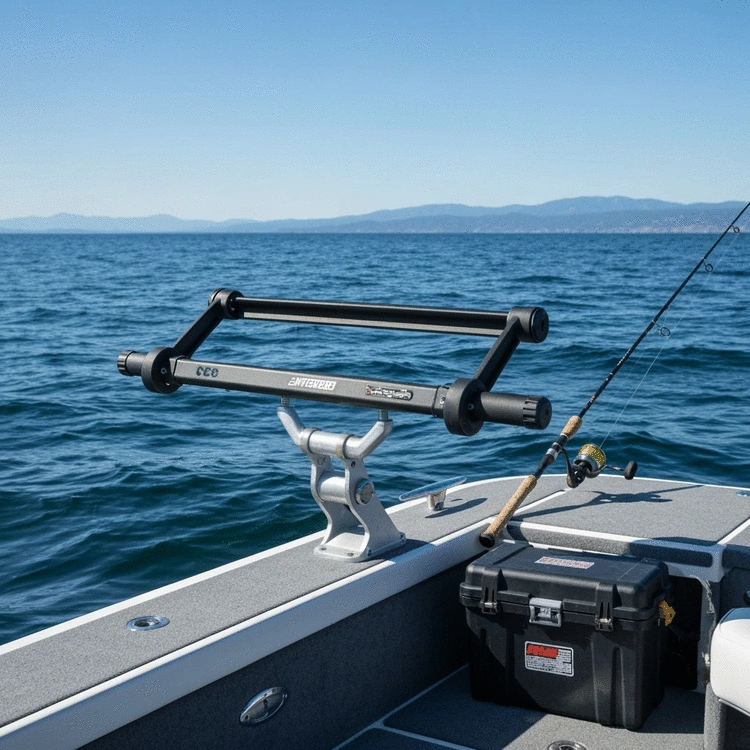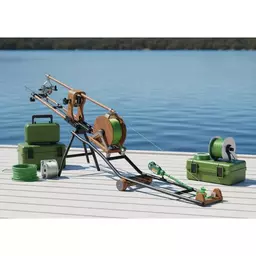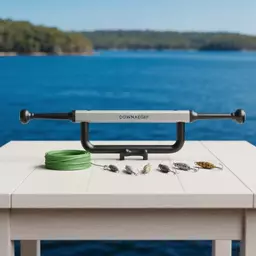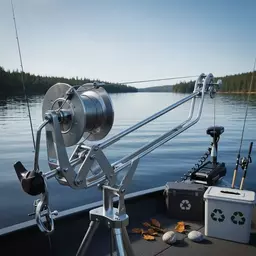Did you know that using downriggers can significantly enhance your fishing success? These tools allow for precise bait placement at varying depths, giving you a strategic advantage. Whether you’re a novice or a seasoned angler, understanding downriggers can transform your fishing experience.
What You Will Learn
- Downriggers provide precise depth control, which is crucial for targeting fish hiding at specific depths.
- Using downriggers can reduce line drag, leading to a more natural bait presentation.
- There are two main types of downriggers: electric and manual, each catering to different fishing preferences.
- User feedback and understanding your fishing environment are key when selecting the right downrigger for your needs.
- Investing in accessories like release clips can greatly improve your chances of a successful catch.
- Choosing the right downrigger can enhance your fishing efficiency and overall enjoyment on the water.
Downrigger Types: A Side-by-Side Comparison
This visual compares the key characteristics and benefits of Electric vs. Manual Downriggers to help you choose the best option for your fishing style.
Downrigger Options Overview
Choosing between electric and manual downriggers depends on your fishing needs and preferences.
Electric Downriggers
- Powered by motor
- Easier to operate
- Saves time & effort
- Ideal for deep fishing
Manual Downriggers
- Requires manual cranking
- More hands-on experience
- Simplicity and reliability
- Good for shallower depths
Consider your fishing style and budget when making your choice. Both options offer great fishing experiences!
Learn MoreUnderstanding Downriggers: A Key Tool for Successful Fishing
When it comes to optimizing your fishing experience, downriggers are an essential tool that can make a significant difference. These devices allow you to precisely control the depth at which your bait or lure is deployed, ensuring it's placed right where the fish are. If you're new to downrigging, don’t worry! I’m here to break down the fundamentals and help you understand why these tools are a vital part of your fishing arsenal. For more insights on selecting the right equipment, consider reading our guide on choosing the right downrigger for you.
So, what exactly is a downrigger? In simple terms, it’s a device that uses a weight to lower your bait to a specific depth. The setup typically includes a fishing line that connects to the weight, which is then released into the water. Once you’re at the desired depth, you can easily monitor the position of your bait, giving you a significant advantage over fish that might be swimming deeper in the water column.
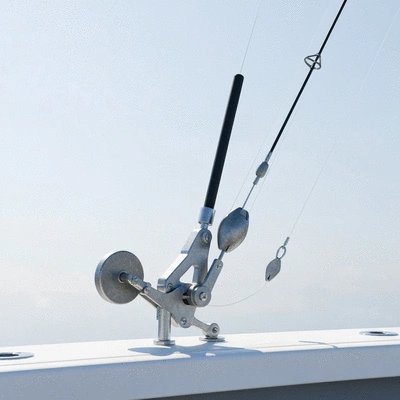
What is a Downrigger and How Does It Work?
A downrigger consists primarily of a spool, a weight, and a release mechanism. The weight helps to sink the bait to the appropriate depth, while the release mechanism allows you to detach the bait from the downrigger when a fish bites. This way, the fish feels less resistance, increasing your chances of a successful catch!
- Spool: Holds the fishing line and is crucial for managing your rig.
- Weight: Varies in size based on the depth you're targeting; heavier weights are used in windy conditions.
- Release Mechanism: Ensures the bait can be released smoothly when a fish strikes.
By utilizing these components effectively, you can enhance your fishing strategy and target specific fish species more successfully.
Benefits of Using Downriggers for Fishing
Using downriggers offers numerous advantages that can elevate your fishing game:
- Increased Depth Control: Fish often hide at specific depths, and a downrigger lets you reach them with precision.
- Less Line Drag: By keeping your bait at a consistent depth, you minimize drag, making your presentation more natural.
- Better Catch Rates: Many anglers report higher success rates when using downriggers—what’s not to love about that?
Moreover, downriggers can facilitate fishing in various conditions, whether you're battling currents or simply want to maintain a steady depth in calm waters. This precision is especially beneficial for downriggers for deep-sea fishing, where targeting specific depths is crucial.
Types of Downriggers: Electric vs. Manual Options
When selecting a downrigger, you'll typically choose between electric and manual options. Each has its pros and cons, depending on your fishing style and needs:
- Electric Downriggers: These are powered by a motor, which makes them easier to operate, especially when fishing at great depths.
- Manual Downriggers: These require you to crank the line manually, which can provide a more hands-on experience but requires more effort.
Personally, I find that electric downriggers can save time and effort, especially during long days of fishing. However, many anglers enjoy the simplicity and reliability of manual options. Ultimately, your choice should reflect your individual fishing needs and preferences.
Pro Tip
When using a downrigger, always pay attention to the thermocline—the layer of water where temperature changes significantly. Fish often congregate near this layer, so adjusting your downrigger to target these depths can greatly enhance your catch rates!
Frequently Asked Questions About Downriggers
Here are some common questions about downriggers to help you further understand their use and benefits:
- Q: What is the primary purpose of a downrigger?
- A: The primary purpose of a downrigger is to precisely control the depth of your bait or lure, allowing you to target fish at specific depths where they are most likely to be found.
- Q: What are the main types of downriggers?
- A: The two main types are electric downriggers, which are motor-powered and easier for deep fishing, and manual downriggers, which require hand-cranking and offer a more hands-on experience.
- Q: How do downriggers improve catch rates?
- A: Downriggers improve catch rates by allowing precise depth control, minimizing line drag for a more natural bait presentation, and enabling anglers to consistently place bait in the fish-holding zone.
- Q: What accessories are important for downrigging?
- A: Key accessories include various weights for different depths, release clips to detach the fishing line from the downrigger weight when a fish strikes, and rod holders designed for downrigger setups.
- Q: Should I choose an electric or manual downrigger?
- A: Your choice depends on your fishing style and needs. Electric downriggers are ideal for deep water and convenience, while manual downriggers are simpler, more reliable, and suitable for shallower depths or those who prefer a more traditional approach.
Summarizing Your Downrigger Choices
Choosing the right downrigger can be a game changer for your fishing adventures! It’s essential to consider your specific needs and how each option fits into your fishing style. Here are some key takeaways to help you make an informed decision:
- Understand your fishing environment: Whether you’re fishing in saltwater or freshwater, the right downrigger will vary based on the conditions.
- Consider the weight: Your chosen downrigger should be compatible with the weights you'll use for effective depth control.
- Evaluate user feedback: Insights from fellow anglers can guide you toward reliable brands and models that have stood the test of time.
- Assess your budget: Quality doesn’t have to break the bank; there are excellent budget-friendly options available.
As you summarize your options, remember that there is no one-size-fits-all solution. Each angler's experience is unique, and what works for one might not work for another. So, take your time and think about what features are most important to you!
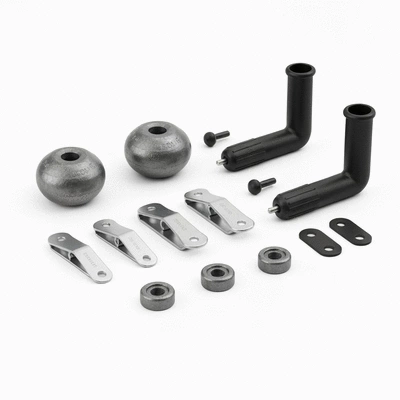
Key Takeaways for Choosing the Best Downrigger
When it comes to selecting the best downrigger, I often advise fellow anglers to focus on these essential factors:
- Type of Downrigger: Decide between electric and manual models based on your comfort level and fishing style.
- Depth Counters: A good depth counter is crucial for tracking your bait’s position accurately.
- Rod Holders: The right rod holders can enhance your fishing efficiency, so choose one that fits well with your setup.
- Accessories: Explore options like release clips and terminal tackle that can improve your overall fishing experience.
These takeaways should empower you to make an informed choice that aligns with your fishing goals. Remember, the right downrigger can make all the difference in your success on the water!
Next Steps: Making an Informed Purchase
Now that you’re equipped with knowledge, it’s time to take the next steps toward purchasing your downrigger! Making an informed decision will ensure you get the best value and performance for your investment.
Where to Buy: Trusted Retailers and Online Platforms
Finding the right downrigger is easier when you know where to look. Here are some trusted retailers and online platforms I frequently recommend:
- Local Fishing Stores: Support your community and check out what local stores have to offer!
- Specialized Online Retailers: Websites like Amazon or dedicated fishing gear sites often have a wide selection and competitive prices.
- Manufacturer Websites: Buying directly from brands like Scotty or Cannon may provide access to exclusive offers.
Ensure you read customer reviews and product descriptions to find out what works best for your fishing style!
Join the Community: Share Your Downrigger Stories and Tips
Joining the fishing community is a fantastic way to enhance your experience. At Downrigger Insights, we encourage sharing your downrigger stories and tips! Engaging with fellow anglers can offer new perspectives and innovative techniques. Consider:
- Social Media Groups: Join fishing groups on platforms like Facebook to connect with other enthusiasts.
- Local Clubs: Engaging with local fishing clubs offers camaraderie and shared learning.
- Online Forums: Sites like Reddit have active fishing communities where you can ask questions and share experiences.
Don’t hesitate to reach out and share your own adventures—everyone has something to contribute! And for tips on maintaining your gear, check out our guide on downrigger care tips for anglers.
Exploring Fishing Blogs and Video Tutorials for Additional Insights
Finally, if you’re looking for more information or inspiration, diving into fishing blogs and video tutorials is a great idea! Here’s how they can help you:
- Step-by-Step Guides: Many blogs provide detailed guides on using specific downriggers and techniques.
- Video Demonstrations: Watching videos can give you a visual understanding of how to set up and use your gear effectively.
- Community Insights: Blogs often feature user comments and experiences that can inform your choices.
Check out resources like Downrigger Insights for quality content tailored to the Australian fishing community. Together, we can learn, improve, and enjoy our time on the water even more!
Recap of Key Points
Here is a quick recap of the important points discussed in the article:
- Understanding Downriggers: Essential tools for controlling bait depth, significantly improving fishing success.
- Components of a Downrigger: Consists of a spool, weight, and release mechanism, each playing a critical role in fishing.
- Benefits: Increased depth control, less line drag, and higher catch rates when using downriggers.
- Types: Choose between electric and manual downriggers based on personal preference and fishing conditions.
- Key Considerations: Understand your fishing environment, evaluate weights, and read user feedback before purchasing.
- Community Engagement: Join fishing groups, clubs, and online forums to enhance your knowledge and share experiences.
